
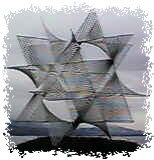 I have recently returned from the excellent European
Case-Based Reasoning Workshop held in Lausanne Switzerland and I told everyone at the
workshop I would write a description of the Workshop and include photos I took of the
workshop with my digital camera. This interesting steel sculpture was on the lake shore
near the hotel. As you can tell from the steel gray sky the weather was not great. But we
were all far too busy in the Workshop to take in the sights anyway. I have recently returned from the excellent European
Case-Based Reasoning Workshop held in Lausanne Switzerland and I told everyone at the
workshop I would write a description of the Workshop and include photos I took of the
workshop with my digital camera. This interesting steel sculpture was on the lake shore
near the hotel. As you can tell from the steel gray sky the weather was not great. But we
were all far too busy in the Workshop to take in the sights anyway.
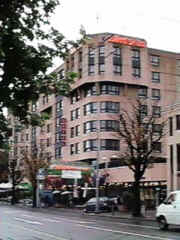 The Workshop hotel was on the lake shore and was extremely comfortable
with several excellent restaurants. The beer in the bar was a little more expensive than
most of us were used to :-( but this was Switzerland after all. The rooms were also great
- so you can see we all had a very comfortable time. The Workshop hotel was on the lake shore and was extremely comfortable
with several excellent restaurants. The beer in the bar was a little more expensive than
most of us were used to :-( but this was Switzerland after all. The rooms were also great
- so you can see we all had a very comfortable time.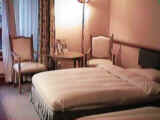
The Movenpick Raddison Hotel
The first day of the Workshop was devoted to
industrial applications of CBR. The session was opened by Philip Klahr
the Vice President of Inference Corporation. He was able to update us on the successful
uptake of Inference's CBR help desk software. In particular Philip concentrated on global
case authoring issues: how a multi-national company that provides customer support for its
products in several countries supports and manages the authoring and distribution of its
case-bases. For companies like Hewlett-Packard or Gateway 2000 this is a non-trivial
problem.
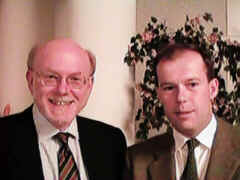 Philip
Klahr and Lawrence Poynter of Inference Philip
Klahr and Lawrence Poynter of Inference
 Jean-Louis Bouchet presented a report on a system
used by the French Atomic Energy Authority for retrieving problems encountered with
nuclear reactors. We were a little alarmed to hear they have a database of over 120,000
logged problems. The system described used a combination of a lexical approach with a
semantic network and case-based retrieval. Jean-Louis Bouchet presented a report on a system
used by the French Atomic Energy Authority for retrieving problems encountered with
nuclear reactors. We were a little alarmed to hear they have a database of over 120,000
logged problems. The system described used a combination of a lexical approach with a
semantic network and case-based retrieval.
No CBR workshop or conference would be complete
without Michel Manago of Acknosoft. He bravely stood in for an absent
colleague and gave an interesting talk on how Sepro Robotique are using CBR to support
fault diagnosis in complex robotic machinery.
Michel also sponsored the Workshop's reception on
the first evening and considering the price of drinks in Switzerland this was very much
appreciated.
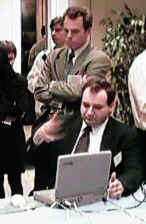
Michel Manago
demonstrating KATE during the software demonstrations
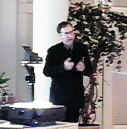 James Barr then asked us, the Workshop, to consider
the more strategic role that CBR could play in corporate knowledge management and gave us
a view of British Airways' perspective on these issues. James Barr then asked us, the Workshop, to consider
the more strategic role that CBR could play in corporate knowledge management and gave us
a view of British Airways' perspective on these issues.
This theme was revisited by Betsy Cordingly
of British Telecom who presented various successful and unsuccessful CBR initiatives that
BT had tried.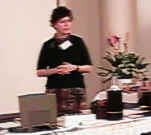
Betsy has kindly made her PowerPoint presentation
available either in HTML format or using Microsoft PowerPoint Animator.
B_CBR_T "CBR in British Telecom" - PowerPoint Animator
The message that came across from all the industrial
speakers was we must be aware of social and organisational problems and issues as well as just
solving technical problems for CBR to be a commercial success.

We then had to leave the hotel and walk a few
hundred yards for lunch at the Chateau d'Ouchy, which was very pleasant, as were all the
meals in Switzerland.
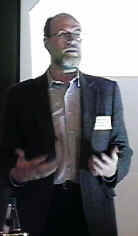 After lunch David Waltz of the NEC Research Institute & Brandeis University
gave a talk on Memory Based Retrieval and an interesting forecasting technique termed
Projective Visualisation. After lunch David Waltz of the NEC Research Institute & Brandeis University
gave a talk on Memory Based Retrieval and an interesting forecasting technique termed
Projective Visualisation.
It was during David's talk that one of the major
themes of the Workshop started to come out. Namely, the trade off between accuracy or
utility and knowledge engineering effort. At the Workshop (and this is a personal opinion)
there were two schools of thought:
- A knowledge engineering-lite school
who would happily use ML or CBR techniques and simple automated adaptation techniques and
accept they might only solve 70-80% of problems reliably.
- A knowledge engineering
school who believe you must model domain knowledge, use semantically and syntactically
rich case representations and knowledge intensive adaptation techniques to improve on
70-80% reliability.
The KE-lite people believe the effort required to
solve more that 70-80% of a problem is not worthwhile particularly in a commercial
context. The other camp think the KE-lite people are ducking the really interesting
problems. This basic difference in approach would arise time and time again during the
presentation of the scientific papers.
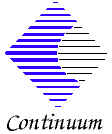 David Waltz appeared to be in
the KE-lite camp as did most of the industrial speakers. This was particularly apparent
when David presented work by Marc Goodman on Projective Visualisation.
This approach is being marketed by a company called Continuum
Software Inc. David Waltz appeared to be in
the KE-lite camp as did most of the industrial speakers. This was particularly apparent
when David presented work by Marc Goodman on Projective Visualisation.
This approach is being marketed by a company called Continuum
Software Inc.
The first day of the workshop ended with software
demonstrations and a reception sponsored by Acknosoft.
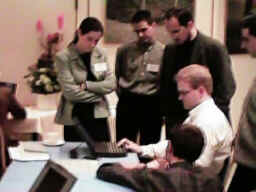 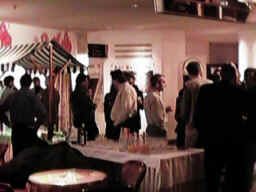
Software demos and
the drinks reception
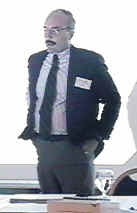 Kevin Ashley started the second day with further
develops of CATO, the trade secrets law CBR system. Kevin Ashley started the second day with further
develops of CATO, the trade secrets law CBR system.
CATO is able to construct complex arguments for a
plaintiff and counter arguments based on case law. The system is definitely not KE-lite
since it uses a complex hierarchy of legal features created by classic knowledge
engineering.
It was interesting to hear how CATO has been
evaluated on law students and that in general it performs as well as a skilled and
experienced human teacher.
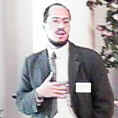 Hector Munoz-Avila presented a CBR system with a
feedback loop for automatically adjusting the weight of features. Assigning weights to
case features has always been problematic since if the weights are wrong they can
profoundly affect the accuracy of retrieval. Hector described a system for incrementally
rewarding or penalising a feature's weight depending on the success or failure of
adaptation. The system called CAPlan therefore uses a case-based approach to optimise its
performance with time. Hector Munoz-Avila presented a CBR system with a
feedback loop for automatically adjusting the weight of features. Assigning weights to
case features has always been problematic since if the weights are wrong they can
profoundly affect the accuracy of retrieval. Hector described a system for incrementally
rewarding or penalising a feature's weight depending on the success or failure of
adaptation. The system called CAPlan therefore uses a case-based approach to optimise its
performance with time.
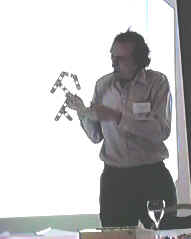 Hugh Osborne, to my mind, then deserved an award for
his excellent use of props. A child's wooden construction set was used to great effect to
illustrate how symbol hierarchies and ordered sets can be manipulated to provide a
similarity metric for cases resulting in a qualitative ranking rather than a numeric
measure of similarity. Hugh Osborne, to my mind, then deserved an award for
his excellent use of props. A child's wooden construction set was used to great effect to
illustrate how symbol hierarchies and ordered sets can be manipulated to provide a
similarity metric for cases resulting in a qualitative ranking rather than a numeric
measure of similarity.
It was interesting to compare Hugh's presentation
with the more formal written paper in the proceedings. 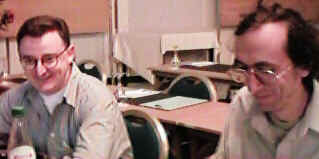
Derek Bridge &
Hugh Osborne of York University
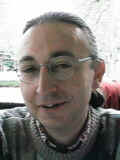 Enric Plaza presented a new technique for measuring
the similitude of hierarchical structures. He presented interesting test data that
compared his technique favourably against standard ML techniques such as C4.5 and CN2. Enric Plaza presented a new technique for measuring
the similitude of hierarchical structures. He presented interesting test data that
compared his technique favourably against standard ML techniques such as C4.5 and CN2.
An alternative way of measuring similarity using
Bayes' Theorem was illustrated by Henry Tirri who wins my award for best
dressed delegate by arriving at the Conference Dinner in an evening suite. 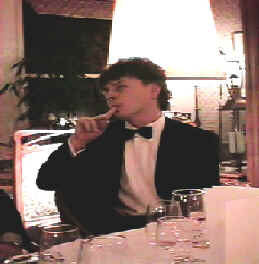
An impeccably dressed
Finn at the Beau Rivage Hotel
A Java demo of Henry's system called D-SIDE is
available at:
http://www.cs.helsinki.fi/research/cosco/
Henry's evening suite bring us nicely onto the
Conference Dinner that was held in a very upmarket hotel. The food was excellent, the
surroundings palatial and the service very attentive. More over, the wine and cognacs kept
flowing.
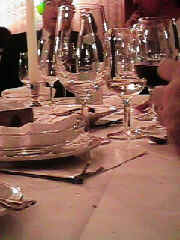 a few glasses on the table a few glasses on the table
The unusual thing I noticed is that on the way home
after dinner my camera wouldn't focus any more....
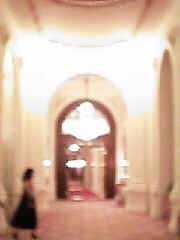 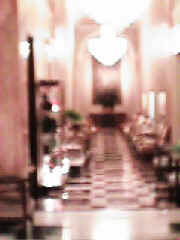
Somewhat blurred
images of the Beau Rivage Hotel, Lausanne
Before dinner an important meeting was
held of the EWCBR96 programme committee and other interested people. At this meeting it
was decided that the Irish would host the next EWCBR in Dublin in 1998. A discussion was
also instigated by Kevin Ashley on whether or not we wanted a CBR
journal. This revisits the discussion instigated by David Aha at ICCBR95
on an organisation or society for CBR since this would be a prerequisite for having our
own journal. In general it was felt that a CBR journal would not succeed yet because
initially it would not have a reputation. Consequently, if we had a good paper we
would choose to send it to a more recognised journal rather than our own CBR journal.
It was decided (and I'm reminding you
if you were there) that those of us who are on editorial boards of journals should lobby
for special issues of the journals dedicated to CBR. This, it was felt, would raise the
profile of CBR to a wider audience and provide us with a place to publish. No decision was
taken on a CBR organisation.
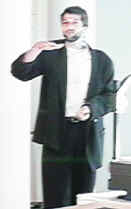 Jorg Schaff of the FABEL group presented a novel
retrieval technique called Fish & Shrink, an improvement on their Fish
& Sink technique. The results presented showed how complex structures can be
retrieved very efficiently. Jorg Schaff of the FABEL group presented a novel
retrieval technique called Fish & Shrink, an improvement on their Fish
& Sink technique. The results presented showed how complex structures can be
retrieved very efficiently.
This is one of the many innovative techniques that
the FABEL project have been experimenting with over the last few years as was also
apparent when Carl-H Coulon presented TOPO: a system that detects
structural similarity in cases and can use this knowledge to guide adaptation.
What seems remarkable about FABEL is that one
project can use so many novel techniques.
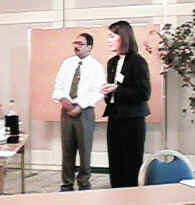
Kathleen Hanney with
A. Goel
The other large contingent at EWCBR96 were the Irish
who presented several papers and posters on their work. Kathleen Hanney
gave a very good talk on a simple system for generating adaptation rules from differences
between similar cases. The technique was explained well and would seem to have general
applicability across many domains. Personally I felt that this was another excellent piece
of work from the Irish labs showing that adaptation can be informed by case data.
I was not alone in my views about Kathleen's work
since she and Mark Keane were subsequently awarded a prize of 500 Swiss
francs and a trophy for the Best Paper at EWCBR 96.
I then had to leave the Workshop to catch my flight
home and so I did not see the last session. However, before I left Michel Manago and Kevin
Ashley had an interesting announcement for an International Summer School on Advanced Information Technologies for
the 3rd Millennium. This would take place for
two weeks in July 1999 on the Greek island of Spetsai. About 100 post-grads and post-docs
would attend to hear lectures from the world's leading authorities in AI, CBR, agents,
etc.. If you are interested contact Kevin or Michel.
Finally, I must thank Ian Smith and
Boi Faltings for chairing and organising this event.
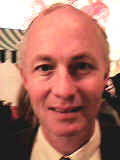 
Ian Smith & Boi
Faltings
See you all in Rhode Island next summer for ICCBR97.
Ian Watson
November 1996

|